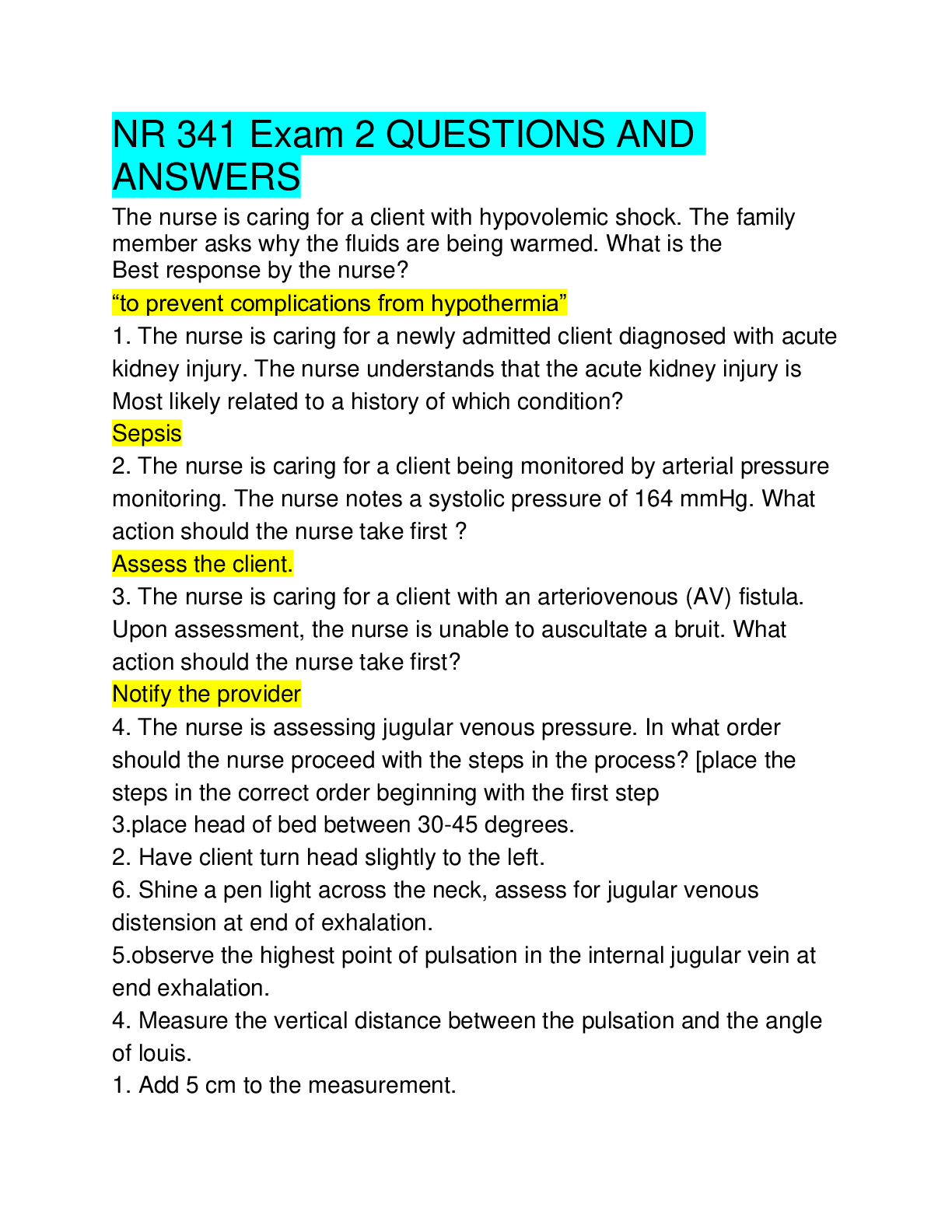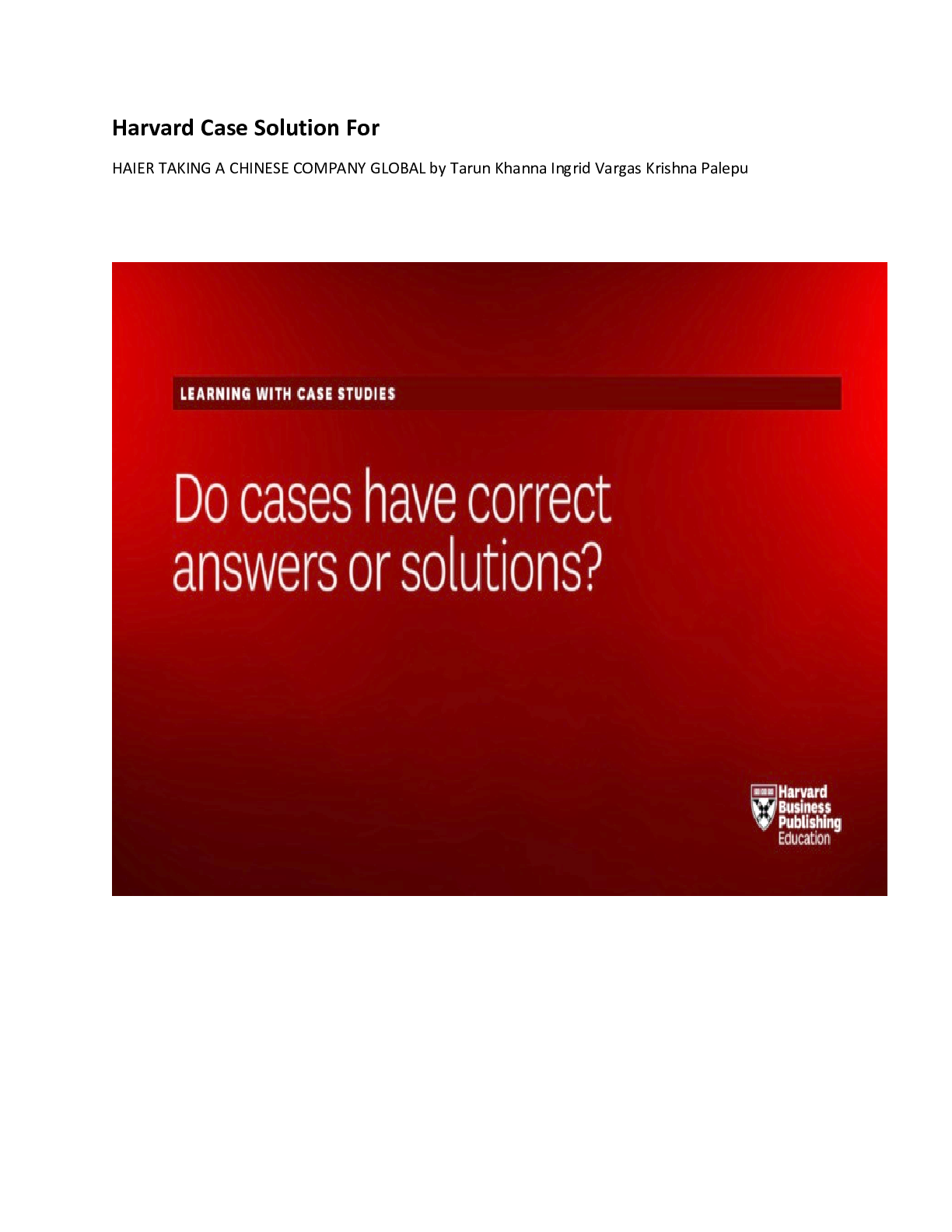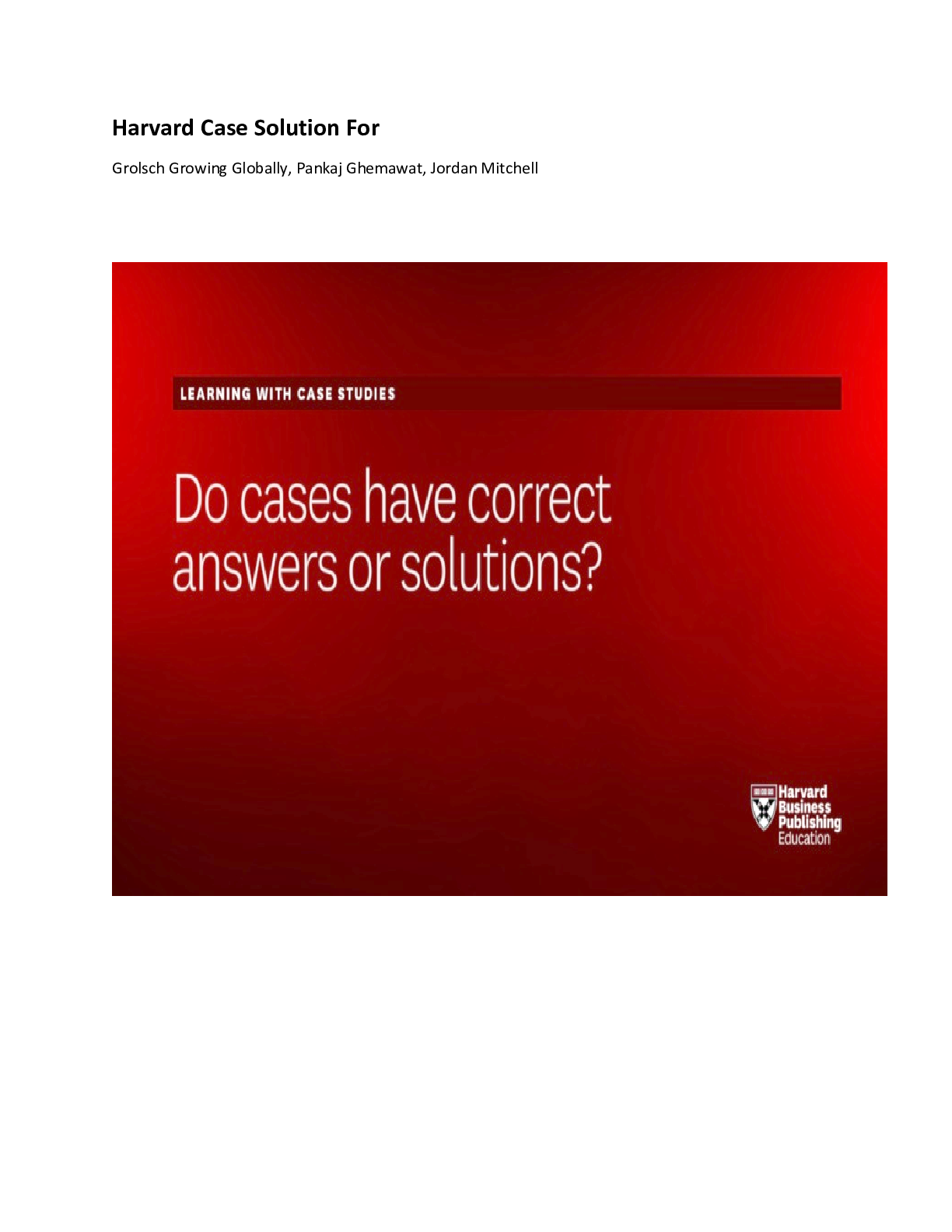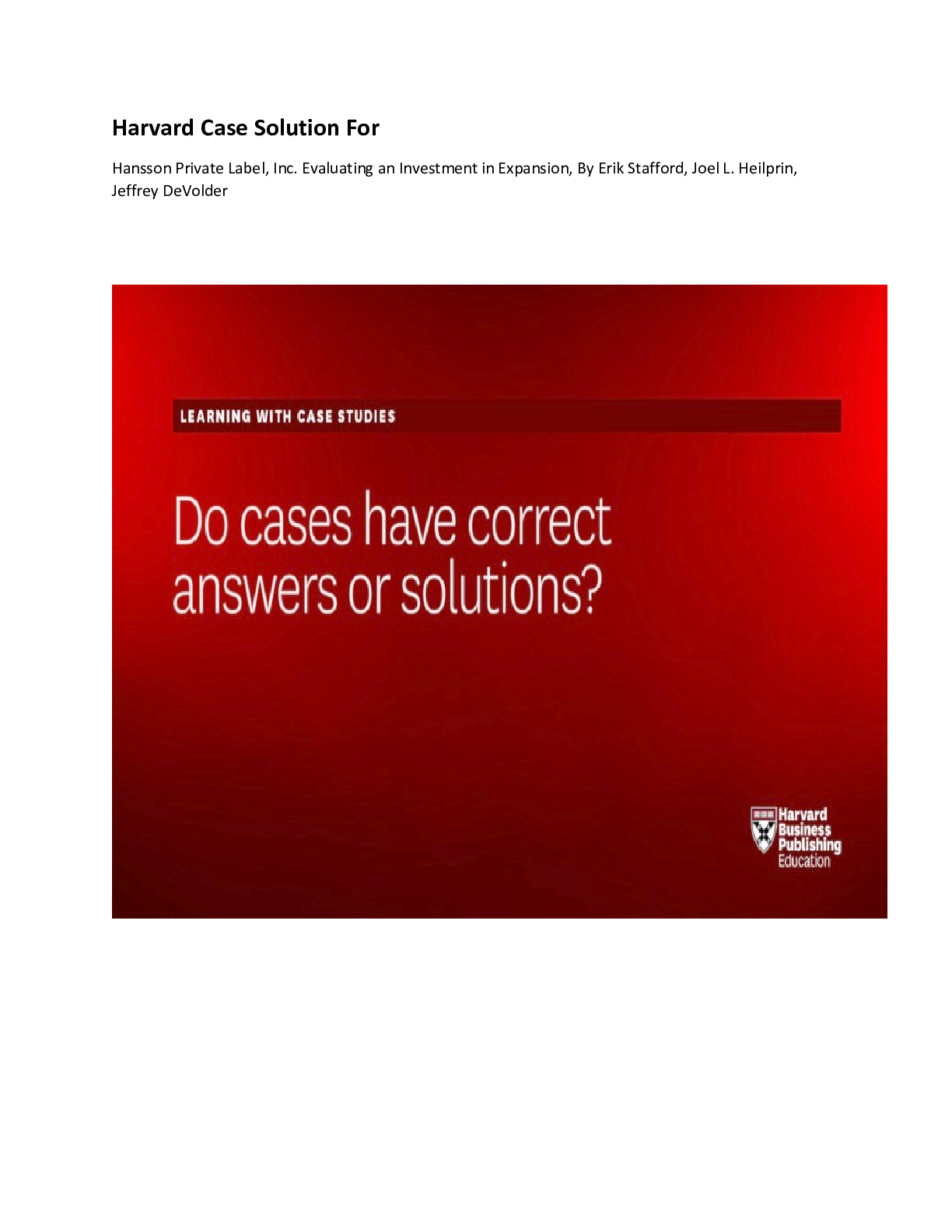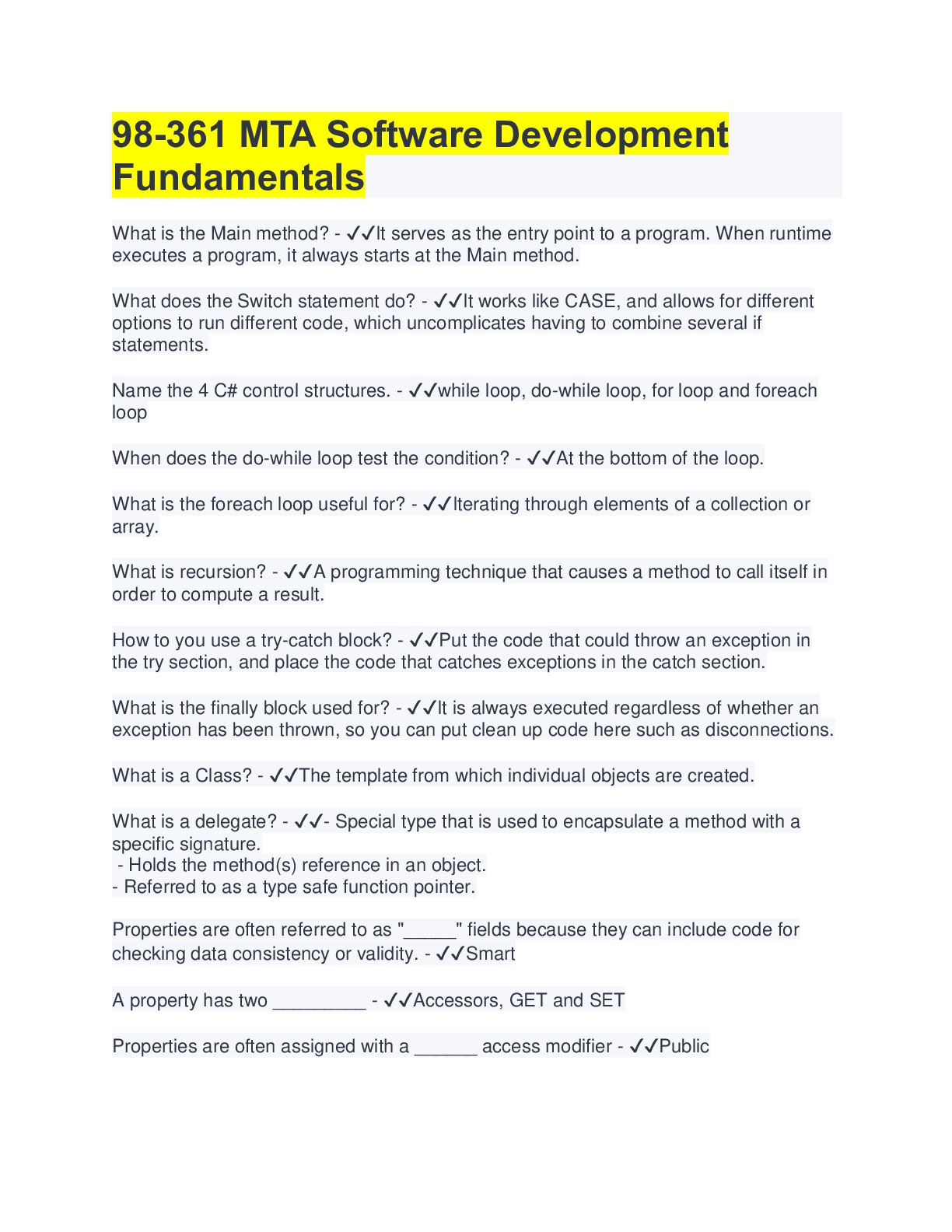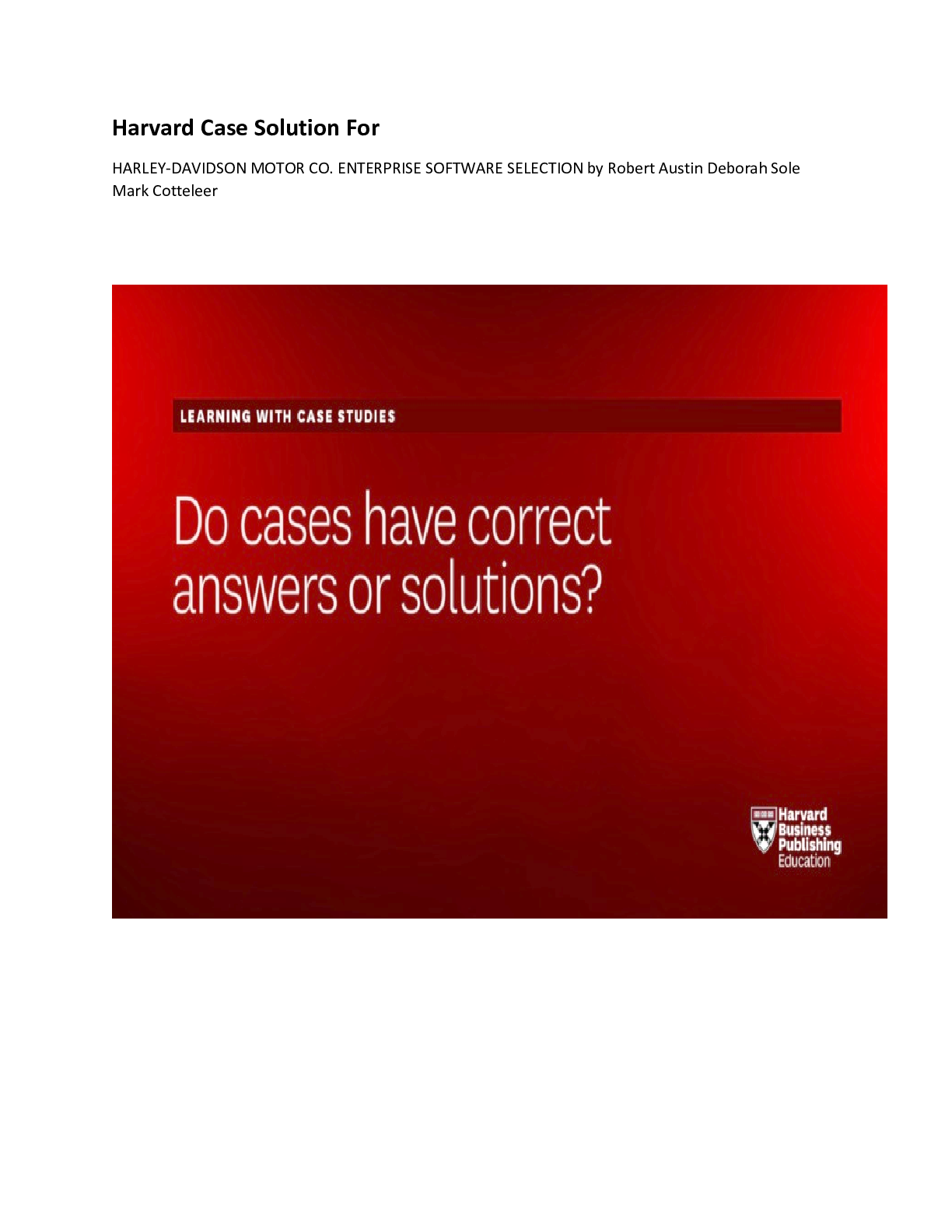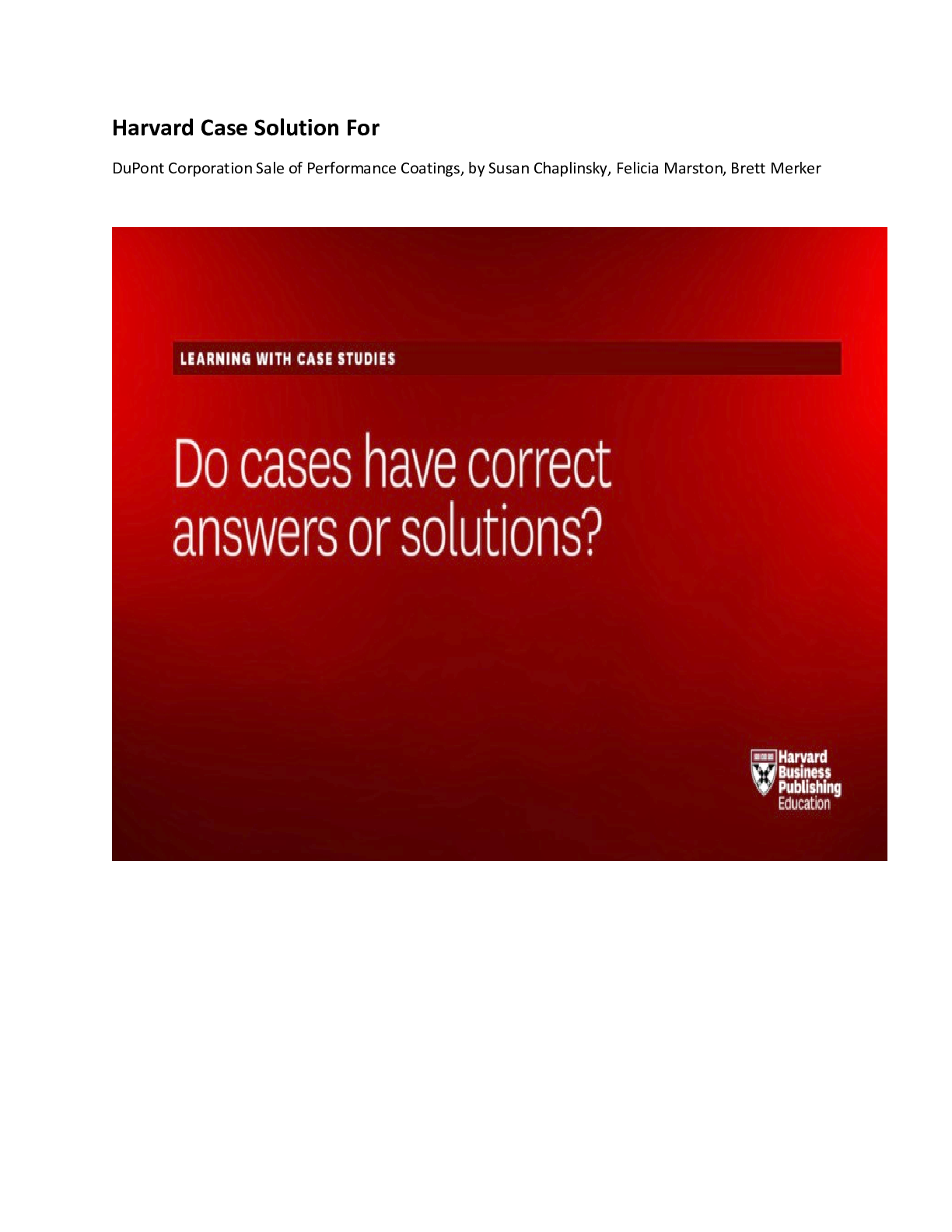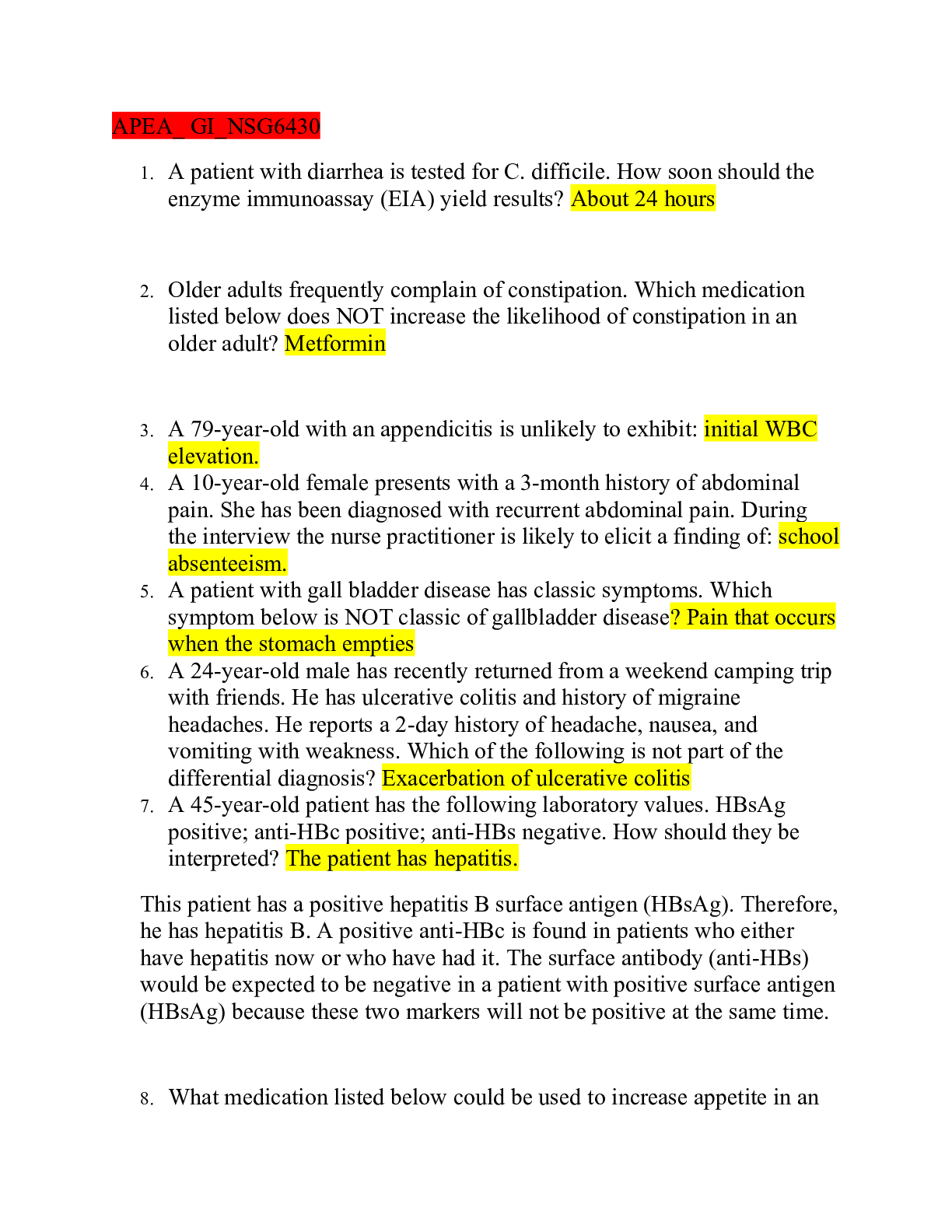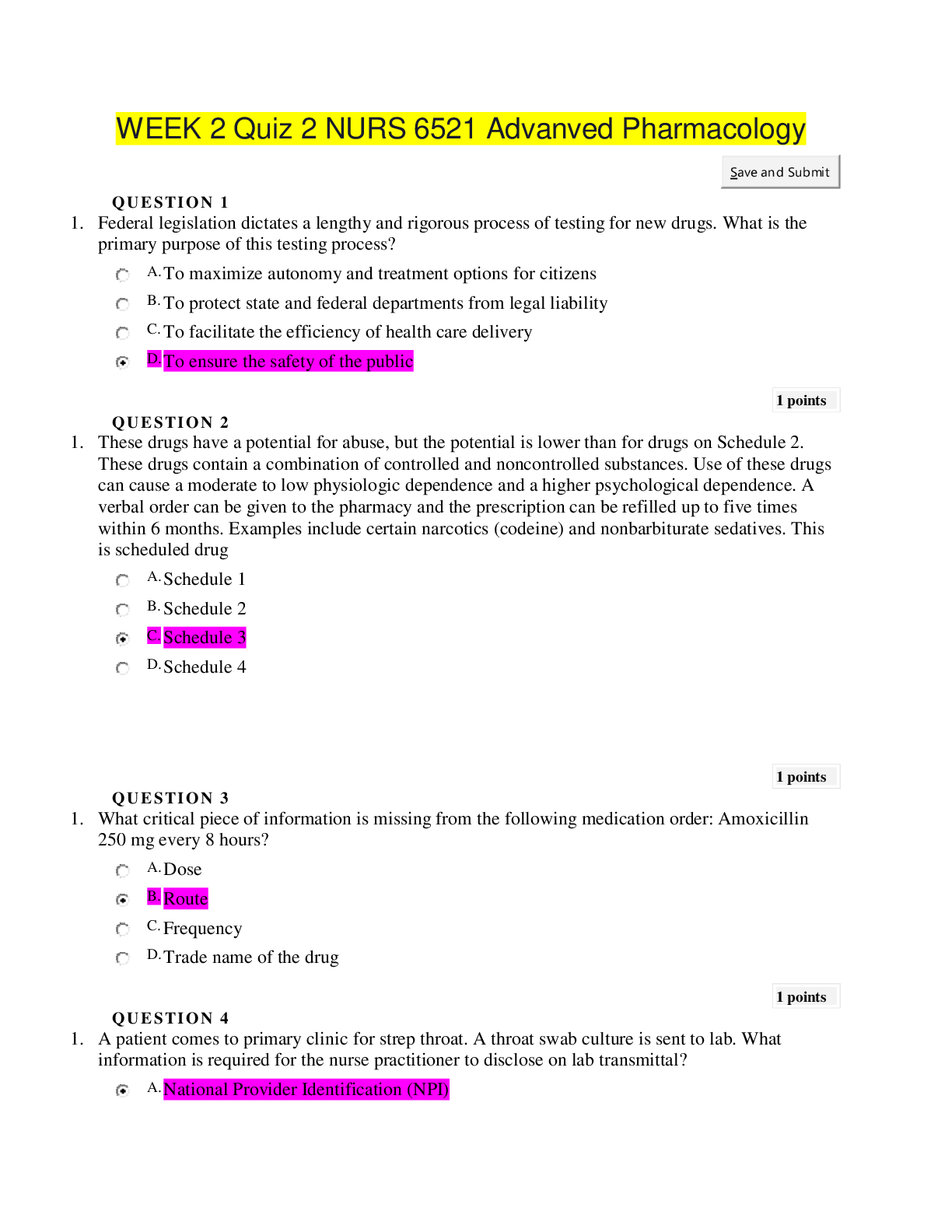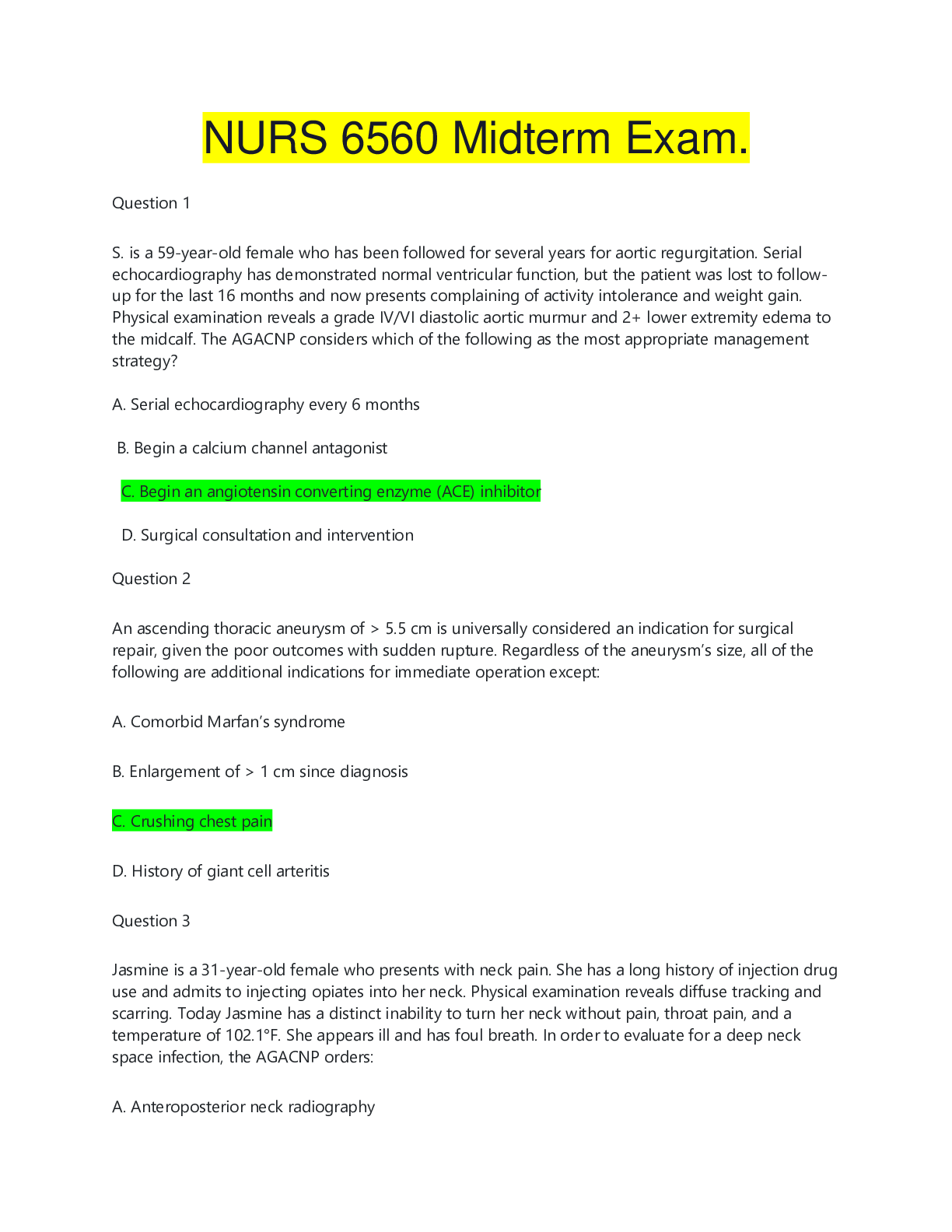Management > EXAM > MGT 3900 Test 1 QUESTIONS AND ANSWERS | VERIFIED SOLUTION (All)
MGT 3900 Test 1 QUESTIONS AND ANSWERS | VERIFIED SOLUTION
Document Content and Description Below
MGT 3900 Test 1 QUESTIONS AND ANSWERS Question 1 A restaurant promising a meal in two minutes or less attempts to cater to which part of the customer utility function? a. Timing b. Fit c. Prefer... ence d. Ambience Question 2 Beyond just executing the current way of doing things, operations management is about: a. eliminating inefficiencies to move the firm away from the efficient frontier. b. managing inputs and resources to move the firm away from the efficient frontier. c. innovating its operations to shift the efficient frontier. d. making strategic trade-offs to do well on all dimensions of the customers’ utility function. Question 3 Three restaurants are compared along the dimensions of responsiveness and cost performance, as shown below: Which of the following conclusions can be drawn about restaurant C? It is inefficient. Pareto dominates A. It is efficient. It is on the efficient frontier. Question 4 A firm investing in a manufacturing plant is an example of which type of costs it incurs as a manufacturer? Resources Variable Marketing Output Question 5 A long waiting line at the checkout of a supermarket at some moments in the day is an example of ____ and a symptom of ____: inflexibility, profit. waste, variability. variability, inflexibility. defect, waste. Question 6 More guests showing up than expected in a party is an example of: demand variability. demand inflexibility. supply variability. supply inflexibility. Question 7 Operations management is about: dealing with customer feedback. doing away with work. improving the way that we and/or others do their work. working harder. Question 8 Which of the following is a definition of the term "process"? A set of activities that combines a collection of units. A set of activities that transforms a collection of inputs into outputs. A set of activities that combines a collection of supplies. A set of activities that transforms a collection of outputs into inputs. Question 9 Which of the following is an appropriate input of a bakery? Flour Baked goods Oven Steel beam Question 10 Which of the following is a key process metric? Inputs Outputs Raw materials Inventory Question 11 Flow rate tells us: how much time stuff spends in the process. how much stuff is needed for the process. how much stuff moves through the process per unit of time. how much stuff is in the process. Question 12 Arrivals and departures to C&A Optometrist are collected and reported below: Patient Arrival Departure 1 7:45 8:45 2 8:00 9:00 3 10:00 10:30 4 10:15 11:45 5 10:35 12:00 What is the average flow time of its patients in minutes? 60 63 65 90 Question 13 C&A Bakery serves 100 customers over the course of an 8-hour day. What is the flow rate of customers in this bakery per hour? 13 12 12.5 (100 customers per hr/(8hr*60min per hour))*60mins per hour = 12.5 customers per hr 10 Question 14 The flow rate of customers at a state fair is 100 per hour. The fair is open from 8 a.m. to 8 p.m. How many customers come through the fair during that time? 100 1200 Number of customers = 100 customers per hour × 12 hours = 1200 120 1000 Question 15 Ten customers visit C&A Bakery from 8 a.m. to 10 a.m. The customers spend 10, 15, 20, 11, 8, 12, 25, 18, 29, and 32 minutes in the bakery. On average, how many customers are in the bakery from 8 a.m. to 10 a.m.? 1.5 Cannot be determined 90 10 Average flow time is (10 + 15 + 20 + 11 + 8 + 12 + 25 + 18 + 29 + 32)/10 = 18 Mins. 8Am- 10Am there are 2 hours 60mins*2 hours= 120 min Average flow rate = 10 customers/120 minutes = 1/12 customer per minute. Inventory = 18*1/12= 1.5 customers Question 16 A drive-through at C&A Fast Food serves 300 customers over a 10-hour day. On average, a customer spends 2 minutes waiting in line, 3 minutes placing the order, and 5 minutes completing the order before leaving the drive-through. How many customers on average are "in" the drive-through (i.e., from the time they enter to the time they exit the drive-through) on a typical day? 5 300 30 Total customers=300 Total hours=10 Average customer=300/10 =30 10 Question 17 Twenty new members are elected to an agency every two years. The agency has 100 members on average overall. How long does a member hold his/her position at the agency? 5 years 10 years 50 years 20 years Inventory = 100 members. Flow rate = 20/2 = 10 new members per year. Flow time = 100/10 = 10 years. Question 18 Which of the following process flow diagrams is a correct depiction of the checkout process at a store: "Customers wait in line at a common area and will be checked out by the next available cashier." Question 19 One employee is in charge of the following activities at a drive-through of a bank: Activity Activity Time per Customer Greet customer 2 seconds Take order 3 seconds Process order 2 minutes (120 seconds) Print receipt 10 seconds What is the capacity (in customers per hour) of the employee? 26.67 capacity=1hr / processing time 3600sec per hr / (2+3+120+10) = 26.67 0.44 0.007 33.75 Question 20 A bank has three tellers. It takes a teller 6 minutes to serve one customer. What is the capacity of the bank (in customers per hour) over the course of an 8-hour workday? 144 160 48 240 (3 tellers / 6 mins per teller) * 60 mins per hr * 8 hr day = Question 21 Patients are arriving at a clinic at a rate of two per minute. Each patient’s visit consists of four steps: check in, record vital signs, receive treatment, and check out. A receptionist takes 1 minute to check a patient in. A nurse takes 2 minutes to record the patient’s vital signs. A doctor spends 10 minutes with a patient. A staff member takes 3 minutes to check a patient out. What is the process capacity in patients per hour? 30 60 6 20 Process capacity = Available time per hour/cycle time = 60 minutes/10 minutes per patient = 6 patients per hour Question 22 The capacity of a non-bottleneck resource is __________ the capacity of the process. equal to smaller than The answer depends on the specific process under consideration. larger than Question 23 Job candidates are leaving an office every 50 minutes. Each candidate goes through three activities during the office visit: verification, written test, and interview. Verification takes 1 minute, the written test takes 40 minutes, and the interview takes 10 minutes. Assume there is only one resource dedicated to each activity. What is the bottleneck capacity in candidates per hour? 2.0 2.5 1.5 Capacity = (1 candidate / process time) * 60 min/hr) (1/40)*60=1.5 1.2 Question 24 There are four steps in the manufacturing process of a stuffed toy: cutting, stuffing, sealing, and packaging. There are two employees each for cutting and stuffing but one each for sealing and packaging. The processing times of cutting, stuffing, sealing, and packaging are 8, 5, 3, and 2 seconds per toy. What is the capacity in toys per minute at the resource "stuffing"? 24 capacity at stuffing = (1 / 5 sec) * 60 sec/min * 2employees = 24 12 0.2 0.4 Question 25 Four employees at a fast-food restaurant each perform one of the four activities in serving a customer: greet customer, take order, process order, and deliver order. The processing time for each activity is given as follows: Activity Processing time per customer Greet customer 2 seconds Take order 30 seconds Process order 60 seconds Deliver order 5 seconds Assume demand is unlimited. What is the average labor utilization? 0.50 0.40 0.68 1.62 Question 26 If _________ is constrained, we should _______ the staffing level to raise capacity. capacity, raise capacity, lower demand, lower demand, raise Question 27 C&A Fast Food has four activities in serving a customer: greet customer, take order, process order, and deliver order. Each activity is staffed by one employee (for a total of four employees). The processing time for each activity is given as follows: Activity Processing time per customer Greet customer 2 seconds Take order 30 seconds Process order 60 seconds Deliver order 5 seconds Assume demand is unlimited. To which activity should C&A assign an additional employee in order to increase process capacity? Process order Take order Greet customer Deliver order Question 28 A possible drawback of having each employee specialize in one or several activities in serving customers at a coffee shop is: increased processing time. increased idle time. higher direct labor costs. increased equipment replication. Question 29 Problem Statement Questions 1~4 are based on the same content. Consider a process consisting of three steps conducted sequentially, and each step is staffed by one worker. Assume there exists unlimited demand for the product. • Resource 1 has a processing time of 6 minutes per unit. • Resource 2 has a processing time of 3 minutes per unit. • Resource 3 has a processing time of 5 minutes per unit. What is the capacity of resource 2? (keep two decimals) The capacity of resource 2 is .3300 units per minute. Question 30 Consider a process consisting of three steps conducted sequentially, and each step is staffed by one worker. Assume there exists unlimited demand for the product. • Resource 1 has a processing time of 6 minutes per unit. • Resource 2 has a processing time of 3 minutes per unit. • Resource 3 has a processing time of 5 minutes per unit. The bottleneck is Resource 1. Question 31 Consider a process consisting of three steps conducted sequentially, and each step is staffed by one worker. Assume there exists unlimited demand for the product. • Resource 1 has a processing time of 6 minutes per unit. • Resource 2 has a processing time of 3 minutes per unit. • Resource 3 has a processing time of 5 minutes per unit. What is the utilization of resource 2? The utilization of resource 2 is 50 percent. Question 32 Consider a process consisting of three steps conducted sequentially, and each step is staffed by one worker. Assume there exists unlimited demand for the product. • Resource 1 has a processing time of 6 minutes per unit. • Resource 2 has a processing time of 3 minutes per unit. • Resource 3 has a processing time of 5 minutes per unit. How long does it take the process to produce 200 units starting with an empty system, assuming this is a worker-paced process? It takes 1200 minutes. Question 33 There are four steps in the manufacturing process of a stuffed toy: cutting, stuffing, sealing, and packaging. There are two employees each for cutting and stuffing but one each for sealing and packaging. The processing times of cutting, stuffing, sealing, and packaging are 8, 5, 3, and 2 seconds per toy. Assuming demand is unlimited and this is a worker-paced process, how long does it take (in seconds) to produce 2000 toys starting with an empty system? It takes 8000 seconds. Bottleneck is 4sec/toy * 2000 toys Question 34 Problem Statement Questions 6~10 are based on the same content. Mr. Tiger is a very popular car wash. It offers high-speed car wash services at a reasonable price, so it always has unlimited demand. The service process includes five activities that are conducted in the sequence described below. (The time required for each activity is shown in parenthesis): • Activity 1: Greet customer and explain the selection of services. (1 minute) • Activity 2: Process payment. (1 minute) • Activity 3: Wash the car. (1 minute) • Activity 4: Rinse and dry the car. (2.5 minutes) • Activity 5: Apply polish. (0.5 minutes) Three servers (S1, S2, and S3) offer the services in a worker-paced line. The assignment of tasks to servers is the following: S1 does Activity 1. S2 does activities 2 and 3. S3 does activities 4 and 5. What is the labor content? The labor content is 6 minutes per customer. Question 35 Mr. Tiger is a very popular car wash. It offers high-speed car wash services at a reasonable price, so it always has unlimited demand. The service process includes five activities that are conducted in the sequence described below. (The time required for each activity is shown in parenthesis): • Activity 1: Greet customer and explain the selection of services. (1 minute) • Activity 2: Process payment. (1 minute) • Activity 3: Wash the car. (1 minute) • Activity 4: Rinse and dry the car. (2.5 minutes) • Activity 5: Apply polish. (0.5 minutes) Three servers (S1, S2, and S3) offer the services in a worker-paced line. The assignment of tasks to servers is the following: S1 does Activity 1. S2 does activities 2 and 3. S3 does activities 4 and 5. What is the average labor utilization? (keep two decimals) The average labor utilization is _____ percent. Question 36 Mr. Tiger is a very popular car wash. It offers high-speed car wash services at a reasonable price, so it always has unlimited demand. The service process includes five activities that are conducted in the sequence described below. (The time required for each activity is shown in parenthesis): • Activity 1: Greet customer and explain the selection of services. (1 minute) • Activity 2: Process payment. (1 minute) • Activity 3: Wash the car. (1 minute) • Activity 4: Rinse and dry the car. (2.5 minutes) • Activity 5: Apply polish. (0.5 minutes) Three servers (S1, S2, and S3) offer the services in a worker-paced line. The assignment of tasks to servers is the following: S1 does Activity 1. S2 does activities 2 and 3. S3 does activities 4 and 5. At a wage rate of $20 per hour per employee, what is the cost of direct labor per customer? The cost of direct labor is $________ per customer. Question 37 Mr. Tiger is a very popular car wash. It offers high-speed car wash services at a reasonable price, so it always has unlimited demand. The service process includes five activities that are conducted in the sequence described below. (The time required for each activity is shown in parenthesis): • Activity 1: Greet customer and explain the selection of services. (1 minute) • Activity 2: Process payment. (1 minute) • Activity 3: Wash the car. (1 minute) • Activity 4: Rinse and dry the car. (2.5 minutes) • Activity 5: Apply polish. (0.5 minutes) Three servers (S1, S2, and S3) offer the services in a worker-paced line. The assignment of tasks to servers is the following: S1 does Activity 1. S2 does activities 2 and 3. S3 does activities 4 and 5. If you hire a new employee who will take over Activity 5 and do only that activity, what is the new capacity of your process (in customers per hour)? The new capacity is __________ customers per hour. Question 38 Mr. Tiger is a very popular car wash. It offers high-speed car wash services at a reasonable price, so it always has unlimited demand. The service process includes five activities that are conducted in the sequence described below. (The time required for each activity is shown in parenthesis): • Activity 1: Greet customer and explain the selection of services. (1 minute) • Activity 2: Process payment. (1 minute) • Activity 3: Wash the car. (1 minute) • Activity 4: Rinse and dry the car. (2.5 minutes) • Activity 5: Apply polish. (0.5 minutes) Three servers (S1, S2, and S3) offer the services in a worker-paced line. The assignment of tasks to servers is the following: S1 does Activity 1. S2 does activities 2 and 3. S3 does activities 4 and 5. If you let go of one of the three original employees and reassign the tasks so that the first employee does activities 1, 2, and 3, and the second employee does activities 4 and 5, what is the new cost of direct labor per customer (with the same wage rate of $20 per hour per employee)? The new cost of direct labor is $2 per customer. Question 39 The Geneva Watch Corporation manufactures watches on a conveyor belt with 6 stations. One worker stands at each station and performs the following tasks: Station (Task) Processing Time (in seconds) A (Preparation #1) 68 B (Preparation #2) 60 C (Battery Installation) 70 D (Brand Installation) 58 E (Packaging Preparation) 75 F (Watch Packaging) 64 Workers get paid $10 per hour, per employee. You can ignore any idle time of workers resulting from the beginning or the end of the day. Assume a demand rate of 50 watches per hour. What is the takt time (in seconds)? The takt time is _________ seconds. Question 40 The Geneva Watch Corporation manufactures watches on a conveyor belt with 6 stations. One worker stands at each station and performs the following tasks: Station (Task) Processing Time (in seconds) A (Preparation #1) 68 B (Preparation #2) 60 C (Battery Installation) 70 D (Brand Installation) 58 E (Packaging Preparation) 75 F (Watch Packaging) 64 Workers get paid $10 per hour, per employee. You can ignore any idle time of workers resulting from the beginning or the end of the day. Assume a demand rate of 50 watches per hour and a takt time of 72 seconds. What is the target manpower (keep two decimals)? The target manpower is _________. Question 41 The Geneva Watch Corporation manufactures watches on a conveyor belt with 6 stations. One worker stands at each station and performs the following tasks: Station (Task) Processing Time (in seconds) A (Preparation #1) 68 B (Preparation #2) 60 C (Battery Installation) 70 D (Brand Installation) 58 E (Packaging Preparation) 75 F (Watch Packaging) 64 Workers get paid $10 per hour, per employee. You can ignore any idle time of workers resulting from the beginning or the end of the day. An external supplier suggests to ship the battery module with pre-installed batteries, thereby reducing Step C from 70 seconds to 48 seconds. By how much would the process capacity increase (in watches per second, rounded to the nearest integer)? The process capacity would increase by _______ watches per second. [Show More]
Last updated: 2 years ago
Preview 1 out of 13 pages

Buy this document to get the full access instantly
Instant Download Access after purchase
Buy NowInstant download
We Accept:

Reviews( 0 )
$11.00
Can't find what you want? Try our AI powered Search
Document information
Connected school, study & course
About the document
Uploaded On
Feb 16, 2021
Number of pages
13
Written in
Additional information
This document has been written for:
Uploaded
Feb 16, 2021
Downloads
0
Views
96


